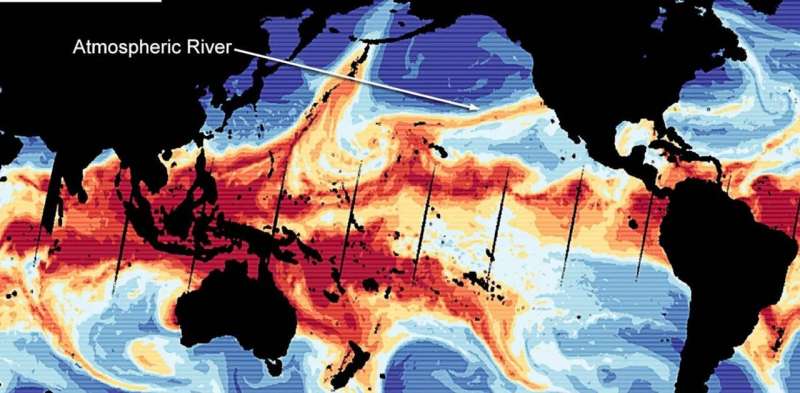Atmospheric rivers, long bands of water vapor that bring heavy rains and storms, are moving toward the poles. This shift is causing droughts in some regions, flooding in others, and risking water resources for many communities. Atmospheric rivers are changing due to natural variability and global warming, with important implications for weather patterns and the climate. Understanding these changes can help improve forecasting and adaptation efforts.

Poleward Shift of Atmospheric Rivers Impacts Global Weather Patterns
Atmospheric rivers, those long, narrow bands of water vapor in the sky that bring heavy rain and storms to the U.S. West Coast and many other regions, are shifting toward higher latitudes. This shift is worsening droughts in some areas, intensifying flooding in others, and putting water resources that many communities rely on at risk.
When atmospheric rivers reach far northward into the Arctic, they can also melt sea ice, affecting the global climate. A recent study published in Science Advances shows that atmospheric rivers have shifted about 6 to 10 degrees toward the two poles over the past four decades, with significant implications for weather patterns around the world.
Atmospheric rivers are not just a U.S. West Coast phenomenon. They form in many parts of the world and provide over half of the mean annual runoff in these regions, including the U.S. Southeast coasts, Southeast Asia, New Zealand, northern Spain, Portugal, the United Kingdom, and south-central Chile. California relies on atmospheric rivers for up to 50% of its yearly rainfall, and a series of winter atmospheric rivers can even end a drought, as parts of the region saw in 2023.
Causes and Consequences of the Poleward Shift in Atmospheric Rivers
The poleward shift of atmospheric rivers is driven by changes in sea surface temperatures in the eastern tropical Pacific Ocean. Since 2000, waters in the eastern tropical Pacific have had a cooling tendency, which affects atmospheric circulation worldwide. This cooling, often associated with La Niña conditions, pushes atmospheric rivers toward the poles.
The poleward movement of atmospheric rivers can be explained as a chain of interconnected processes. During La Niña conditions, the Walker circulation—giant loops of air that affect precipitation as they rise and fall over different parts of the tropics—strengthens over the western Pacific. This stronger circulation causes the tropical rainfall belt to expand. The expanded tropical rainfall, combined with changes in atmospheric eddy patterns, results in high-pressure anomalies and wind patterns that steer atmospheric rivers farther poleward.
Conversely, during El Niño conditions, with warmer sea surface temperatures, the mechanism operates in the opposite direction, shifting atmospheric rivers so they don’t travel as far from the equator.
The shifts in atmospheric rivers raise important questions about how climate models predict future changes. Current models might underestimate natural variability, such as changes in the tropical Pacific, which can significantly affect atmospheric rivers. Understanding this connection can help forecasters make better predictions about future rainfall patterns and water availability.
Implications of Atmospheric River Shifts for Local Climates and Adaptation
A shift in atmospheric rivers can have big effects on local climates. In the subtropics, where atmospheric rivers are becoming less common, the result could be longer droughts and less water. Many areas, such as California and southern Brazil, depend on atmospheric rivers for rainfall to fill reservoirs and support farming. Without this moisture, these areas could face more water shortages, putting stress on communities, farms, and ecosystems.
In higher latitudes, atmospheric rivers moving poleward could lead to more extreme rainfall, flooding, and landslides in places such as the U.S. Pacific Northwest, Europe, and even in polar regions. In the Arctic, more atmospheric rivers could speed up sea ice melting, adding to global warming and affecting animals that rely on the ice.
So far, the shifts in atmospheric rivers mainly reflect changes due to natural processes, but human-induced global warming also plays a role. Global warming is expected to increase the overall frequency and intensity of atmospheric rivers because a warmer atmosphere can hold more moisture. As the world gets warmer, atmospheric rivers—and the critical rains they bring—will keep changing course, and we need to understand and adapt to these changes so communities can keep thriving in a changing climate.
